By: Tori Wood
Skagit Land Trust took on an exciting project this spring. In order to stabilize a rapidly eroding bank on the Sauk-Delachapelle Conservation Easement Skagit Land Trust installed a live fascine with the help of Washington Conservation Corps.
What is a Conservation Easement? Skagit Land Trust has both conservation easements and conservation areas. Conservation Areas are properties that Skagit Land Trust owns outright either by purchase or donation. Conservation Easements are properties that are still privately owned by a land owner. Land owners opt to create a binding agreement with Skagit Land Trust to ensure the land is protected into the future. This means that even if an easement is sold to another person later on, that person must abide by the rules of the easement. These rules vary for each property but they often limit development and disturbance to ecologically significant areas and allow Skagit Land Trust to help manage and restore the property. | | 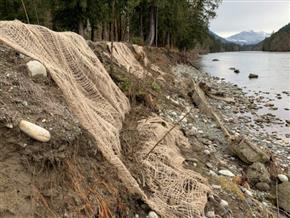 Live Fascine and erosion control fabric installed along the Sauk River. The large pieces of concrete are from an old home foundation that was removed before Skagit Land Trust’s involvement. |
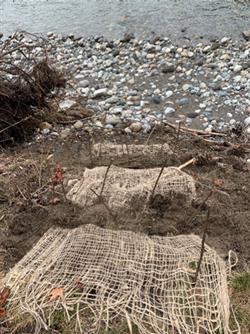 | | What is a Live Fascine? Live fascines are long bundles of live cuttings from woody plants, such as willows, that are spaced along a stream bank and staked in by more live cuttings. The bundles are placed in shallow trenches spaced 3-5 feet apart up the slope and staked in about every 2 feet. Two benefits of live fascines are that they help to stabilize the slope and establish native vegetation. By using live stakes from species that can regrow from cuttings, the hope is that many of the stakes used throughout the fascine will eventually begin to re-root and grow. As the cuttings mature, their root structures will help to further stabilize the bank. In the meantime placing the bundles of live stakes in trenches along the slope will provide some immediate protection from erosion until the live stakes begin to grow and mature.
|
The Project
The project got rolling due to the enthusiasm of the Delachapelle land owners, Pete Delachapelle and Claudia Maple. They specifically purchased this property east of the Sauk River to ensure it would be restored and protected by Skagit Land Trust. Right from the get-go Pete and Claudia were excited about the possibility of doing a live fascine on the riverbank.
The Sauk-Delachapelle Conservation Easement is a unique property spanning both the east and west sides of the Sauk River. At first glance, the eastern side of this easement is not the most enticing piece of land. It is a long, narrow strip between highway 530 and the river. The riverbank has significant open areas where structures once stood and a noticeable lack of native vegetation. In addition, the steep bank leading down to the river is rapidly eroding. While erosion is a natural process as the river’s course and water levels fluctuate, the lack of native trees and shrubs has caused erosion to occur rapidly here. Riparian habitat – that is, vegetated habitat next to a creek, river, or body of water – is incredibly important for many species of wildlife, including salmonids. Riparian areas are especially important in areas adjacent to highly disturbed areas, such as a road, as they create a safe buffer of suitable habitat for species to utilize away from areas with heavy human use.
| 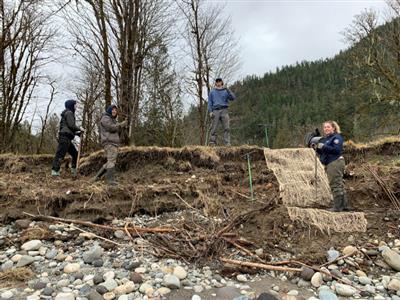 The WCC Crew hard at work installing the fascine. (Left – Right) Mary Hemminger, Dax Williams, Maia Kattenbraker, and Ashley Baltrusitis. The WCC Crew hard at work installing the fascine. (Left – Right) Mary Hemminger, Dax Williams, Maia Kattenbraker, and Ashley Baltrusitis.
| |
This spring, Skagit Land Trust’s Stewardship AmeriCorps went out to the property with a Washington Conservation Corps (WCC) crew to install the fascine. They also laid down erosion control fabric in some especially erosion-prone areas. The team worked their way down 500 ft. of shoreline along the Sauk River placing fascines in nearly all accessible areas of the bank.
This project was an exciting endeavor for Skagit Land Trust. Not only was it the first live fascine project we have ever done, but it was also a huge learning experience for our AmeriCorps Member, Tori, who took lead on the project. While it will take some time to know exactly how successful the live fascine will be, the Trust is hopeful that many of the live stakes will root and help stabilize the riverbank. This was an important step in restoring the riparian area along the Sauk River and we are excited to see how things progress.
| 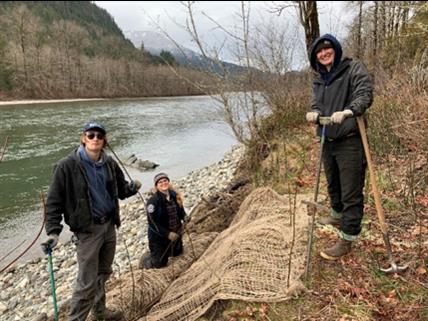 Two WCC crew members, Maia Kattenbraker (left) and Mary Hemminger (right) working with Tori, our Stewardship AmeriCorps (center) to install the live fascine over erosion control fabric. Two WCC crew members, Maia Kattenbraker (left) and Mary Hemminger (right) working with Tori, our Stewardship AmeriCorps (center) to install the live fascine over erosion control fabric.
| |
Update: Live Stakes are Doing Great The willow stakes seem to be doing very well - some are already beginning to leaf out! This is a good sign that the live stakes will continue to grow and establish roots to stabilize the slope. Though we will have to continue to monitor this site to determine its success, these first signs of growth give us hope for the future. | | 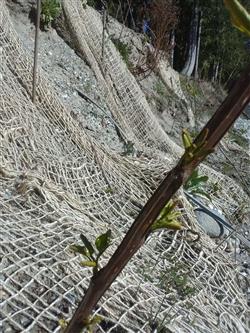 |